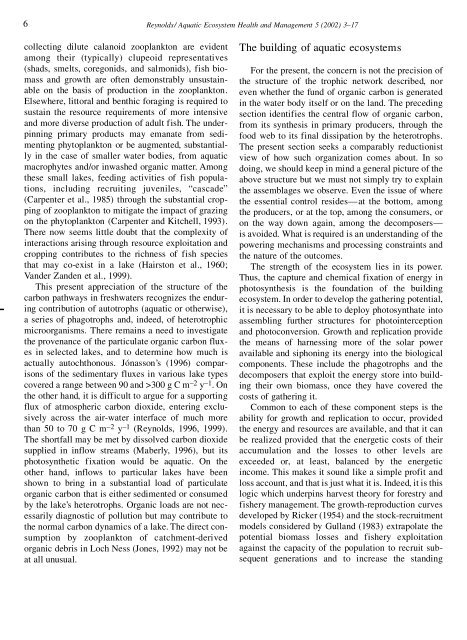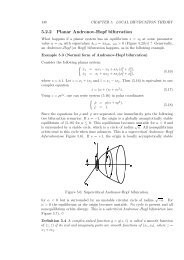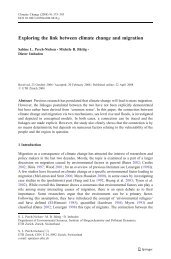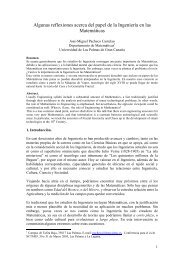Resilience in aquatic ecosystems - hysteresis, homeostasis, and ...
Resilience in aquatic ecosystems - hysteresis, homeostasis, and ...
Resilience in aquatic ecosystems - hysteresis, homeostasis, and ...
Create successful ePaper yourself
Turn your PDF publications into a flip-book with our unique Google optimized e-Paper software.
6<br />
Reynolds/ Aquatic Ecosystem Health <strong>and</strong> Management 5 (2002) 3–17<br />
collect<strong>in</strong>g dilute calanoid zooplankton are evident<br />
among their (typically) clupeoid representatives<br />
(shads, smelts, coregonids, <strong>and</strong> salmonids), fish biomass<br />
<strong>and</strong> growth are often demonstrably unsusta<strong>in</strong>able<br />
on the basis of production <strong>in</strong> the zooplankton.<br />
Elsewhere, littoral <strong>and</strong> benthic forag<strong>in</strong>g is required to<br />
susta<strong>in</strong> the resource requirements of more <strong>in</strong>tensive<br />
<strong>and</strong> more diverse production of adult fish. The underp<strong>in</strong>n<strong>in</strong>g<br />
primary products may emanate from sediment<strong>in</strong>g<br />
phytoplankton or be augmented, substantially<br />
<strong>in</strong> the case of smaller water bodies, from <strong>aquatic</strong><br />
macrophytes <strong>and</strong>/or <strong>in</strong>washed organic matter. Among<br />
these small lakes, feed<strong>in</strong>g activities of fish populations,<br />
<strong>in</strong>clud<strong>in</strong>g recruit<strong>in</strong>g juveniles, “cascade”<br />
(Carpenter et al., 1985) through the substantial cropp<strong>in</strong>g<br />
of zooplankton to mitigate the impact of graz<strong>in</strong>g<br />
on the phytoplankton (Carpenter <strong>and</strong> Kitchell, 1993).<br />
There now seems little doubt that the complexity of<br />
<strong>in</strong>teractions aris<strong>in</strong>g through resource exploitation <strong>and</strong><br />
cropp<strong>in</strong>g contributes to the richness of fish species<br />
that may co-exist <strong>in</strong> a lake (Hairston et al., 1960;<br />
V<strong>and</strong>er Z<strong>and</strong>en et al., 1999).<br />
This present appreciation of the structure of the<br />
carbon pathways <strong>in</strong> freshwaters recognizes the endur<strong>in</strong>g<br />
contribution of autotrophs (<strong>aquatic</strong> or otherwise),<br />
a series of phagotrophs <strong>and</strong>, <strong>in</strong>deed, of heterotrophic<br />
microorganisms. There rema<strong>in</strong>s a need to <strong>in</strong>vestigate<br />
the provenance of the particulate organic carbon fluxes<br />
<strong>in</strong> selected lakes, <strong>and</strong> to determ<strong>in</strong>e how much is<br />
actually autochthonous. Jónasson’s (1996) comparisons<br />
of the sedimentary fluxes <strong>in</strong> various lake types<br />
covered a range between 90 <strong>and</strong> >300 g C m –2 y –1 . On<br />
the other h<strong>and</strong>, it is difficult to argue for a support<strong>in</strong>g<br />
flux of atmospheric carbon dioxide, enter<strong>in</strong>g exclusively<br />
across the air-water <strong>in</strong>terface of much more<br />
than 50 to 70 g C m –2 y –1 (Reynolds, 1996, 1999).<br />
The shortfall may be met by dissolved carbon dioxide<br />
supplied <strong>in</strong> <strong>in</strong>flow streams (Maberly, 1996), but its<br />
photosynthetic fixation would be <strong>aquatic</strong>. On the<br />
other h<strong>and</strong>, <strong>in</strong>flows to particular lakes have been<br />
shown to br<strong>in</strong>g <strong>in</strong> a substantial load of particulate<br />
organic carbon that is either sedimented or consumed<br />
by the lake’s heterotrophs. Organic loads are not necessarily<br />
diagnostic of pollution but may contribute to<br />
the normal carbon dynamics of a lake. The direct consumption<br />
by zooplankton of catchment-derived<br />
organic debris <strong>in</strong> Loch Ness (Jones, 1992) may not be<br />
at all unusual.<br />
The build<strong>in</strong>g of <strong>aquatic</strong> <strong>ecosystems</strong><br />
For the present, the concern is not the precision of<br />
the structure of the trophic network described, nor<br />
even whether the fund of organic carbon is generated<br />
<strong>in</strong> the water body itself or on the l<strong>and</strong>. The preced<strong>in</strong>g<br />
section identifies the central flow of organic carbon,<br />
from its synthesis <strong>in</strong> primary producers, through the<br />
food web to its f<strong>in</strong>al dissipation by the heterotrophs.<br />
The present section seeks a comparably reductionist<br />
view of how such organization comes about. In so<br />
do<strong>in</strong>g, we should keep <strong>in</strong> m<strong>in</strong>d a general picture of the<br />
above structure but we must not simply try to expla<strong>in</strong><br />
the assemblages we observe. Even the issue of where<br />
the essential control resides—at the bottom, among<br />
the producers, or at the top, among the consumers, or<br />
on the way down aga<strong>in</strong>, among the decomposers—<br />
is avoided. What is required is an underst<strong>and</strong><strong>in</strong>g of the<br />
power<strong>in</strong>g mechanisms <strong>and</strong> process<strong>in</strong>g constra<strong>in</strong>ts <strong>and</strong><br />
the nature of the outcomes.<br />
The strength of the ecosystem lies <strong>in</strong> its power.<br />
Thus, the capture <strong>and</strong> chemical fixation of energy <strong>in</strong><br />
photosynthesis is the foundation of the build<strong>in</strong>g<br />
ecosystem. In order to develop the gather<strong>in</strong>g potential,<br />
it is necessary to be able to deploy photosynthate <strong>in</strong>to<br />
assembl<strong>in</strong>g further structures for photo<strong>in</strong>terception<br />
<strong>and</strong> photoconversion. Growth <strong>and</strong> replication provide<br />
the means of harness<strong>in</strong>g more of the solar power<br />
available <strong>and</strong> siphon<strong>in</strong>g its energy <strong>in</strong>to the biological<br />
components. These <strong>in</strong>clude the phagotrophs <strong>and</strong> the<br />
decomposers that exploit the energy store <strong>in</strong>to build<strong>in</strong>g<br />
their own biomass, once they have covered the<br />
costs of gather<strong>in</strong>g it.<br />
Common to each of these component steps is the<br />
ability for growth <strong>and</strong> replication to occur, provided<br />
the energy <strong>and</strong> resources are available, <strong>and</strong> that it can<br />
be realized provided that the energetic costs of their<br />
accumulation <strong>and</strong> the losses to other levels are<br />
exceeded or, at least, balanced by the energetic<br />
<strong>in</strong>come. This makes it sound like a simple profit <strong>and</strong><br />
loss account, <strong>and</strong> that is just what it is. Indeed, it is this<br />
logic which underp<strong>in</strong>s harvest theory for forestry <strong>and</strong><br />
fishery management. The growth-reproduction curves<br />
developed by Ricker (1954) <strong>and</strong> the stock-recruitment<br />
models considered by Gull<strong>and</strong> (1983) extrapolate the<br />
potential biomass losses <strong>and</strong> fishery exploitation<br />
aga<strong>in</strong>st the capacity of the population to recruit subsequent<br />
generations <strong>and</strong> to <strong>in</strong>crease the st<strong>and</strong><strong>in</strong>g






